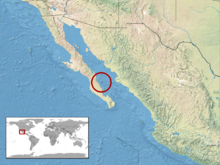Santa Catalina rattlesnake
| Santa Catalina rattlesnake | |
|---|---|

| |
| Scientific classification | |
| Domain: | Eukaryota |
| Kingdom: | Animalia |
| Phylum: | Chordata |
| Class: | Reptilia |
| Order: | Squamata |
| Suborder: | Serpentes |
| Family: | Viperidae |
| Genus: | Crotalus |
| Species: | C. catalinensis
|
| Binomial name | |
| Crotalus catalinensis | |

| |
The Santa Catalina Rattlesnake (Crotalus catalinensis), also known as the "Santa Catalina Island Rattlesnake", is a species of venomous Pit viper found only on Santa Catalina Island in the Gulf of California. There are currently no subspecies recognized.
Description[change | change source]
The Santa Catalina Rattlesnake is a small and slender species of rattlesnake. It can grow up to the length of 73.1 centimeters (28.8 in), and is known for being one of the few rattlesnakes which don't have a rattle on the end of their tail. Some Santa Catalina Rattlesnakes are light cream in color with reddish-brown blotches down their back, while some are ash gray with dark gray blotches on them.
Behavior[change | change source]
While other rattlesnakes of the genus "Crotalus" are mainly terrestrial (live on land), the Santa Catalina Rattlesnake's small size makes it very good climber. In July, the hottest month on Santa Catalina Island, the Santa Catalina Rattlesnake is found on branches of bushes and trees so they can escape the heat on the ground.
Feeding[change | change source]
Since the Santa Catalina Rattlesnake lives mainly in trees, scientist first thought this rattlesnake eats birds, but scientist have now found out that around 70% of the Santa Catalina Rattlesnake's diet is made up of small mammals like the Santa Catalina Deer Mouse, and around 30% is made up of lizards like the Santa Catalina Desert Iguana and the Santa Catalina Side-blotched lizard.
References[change | change source]
- ↑ https://www.iucnredlist.org/species/64314/12764544
- ↑ McDiarmid RW, Campbell JA, Touré T. 1999. Snake Species of the World: A Taxonomic and Geographic Reference, vol. 1. Herpetologists' League. 511 pp. ISBN 1-893777-00-6 (series). ISBN 1-893777-01-4 (volume).

